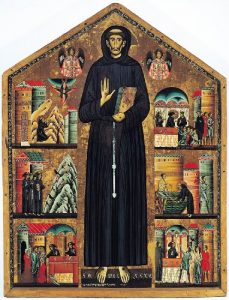- Annotated with suggested further readings and inline links to additional web content.
Saint Francis of Assisi (born Giovanni Francesco di Bernardone; 1181/1182 – October 3, 1226)[2] was an Italian Catholic friar and preacher. He founded the men's Franciscan Order, the women’s Order of St. Clare, and the lay Third Order of Saint Francis.[3] St. Francis is one of the most venerated religious figures in history.[3]
Francis was the son of a wealthy cloth merchant in Assisi, and he lived the high-spirited life typical of a wealthy young man, even fighting as a soldier for Assisi.[4] While going off to war in 1204, Francis had a vision that directed him back to Assisi, where he lost his taste for his worldly life.[4] On a pilgrimage to Rome, Francis begged with the beggars at St. Peter's.[4] The experience moved him to live in poverty.[4] Francis returned home, began preaching on the streets, and soon amassed a following. His order was endorsed by Pope Innocent III in 1210. He then founded the Order of Poor Clares, which was an enclosed order for women, as well as the Third Order of Brothers and Sisters of Penance. In 1219, he went to Egypt where crusaders were besieging Damietta, hoping to find martyrdom at the hands of the Muslims. By this point, the Franciscan Order had grown to such an extent that its primitive organizational structure was no longer sufficient. He returned to Italy to organize the order. Once his organization was endorsed by the Pope, he withdrew increasingly from external affairs. In 1223, Francis arranged for the first Christmas manger scene.[4] In 1224, he received the stigmata,[4] making him the first person to bear the wounds of Christ's Passion.[5] He died in 1226 while singing Psalm 141.
On July 16, 1228, he was pronounced a saint by Pope Gregory IX. He is known as the patron saint of animals, the environment and one of the two patrons of Italy (with Catherine of Siena), and it is customary for Catholic and Anglican churches to hold ceremonies blessing animals on his feast day of 4 October.[6]
Saint Francis of Assisi (born Giovanni Francesco di Bernardone; 1181/1182 – October 3, 1226)[2] was an Italian Catholic friar and preacher. He founded the men's Franciscan Order, the women’s Order of St. Clare, and the lay Third Order of Saint Francis.[3] St. Francis is one of the most venerated religious figures in history.[3]
Francis was the son of a wealthy cloth merchant in Assisi, and he lived the high-spirited life typical of a wealthy young man, even fighting as a soldier for Assisi.[4] While going off to war in 1204, Francis had a vision that directed him back to Assisi, where he lost his taste for his worldly life.[4] On a pilgrimage to Rome, Francis begged with the beggars at St. Peter's.[4] The experience moved him to live in poverty.[4] Francis returned home, began preaching on the streets, and soon amassed a following. His order was endorsed by Pope Innocent III in 1210. He then founded the Order of Poor Clares, which was an enclosed order for women, as well as the Third Order of Brothers and Sisters of Penance. In 1219, he went to Egypt where crusaders were besieging Damietta, hoping to find martyrdom at the hands of the Muslims. By this point, the Franciscan Order had grown to such an extent that its primitive organizational structure was no longer sufficient. He returned to Italy to organize the order. Once his organization was endorsed by the Pope, he withdrew increasingly from external affairs. In 1223, Francis arranged for the first Christmas manger scene.[4] In 1224, he received the stigmata,[4] making him the first person to bear the wounds of Christ's Passion.[5] He died in 1226 while singing Psalm 141.
On July 16, 1228, he was pronounced a saint by Pope Gregory IX. He is known as the patron saint of animals, the environment and one of the two patrons of Italy (with Catherine of Siena), and it is customary for Catholic and Anglican churches to hold ceremonies blessing animals on his feast day of 4 October.[6]






